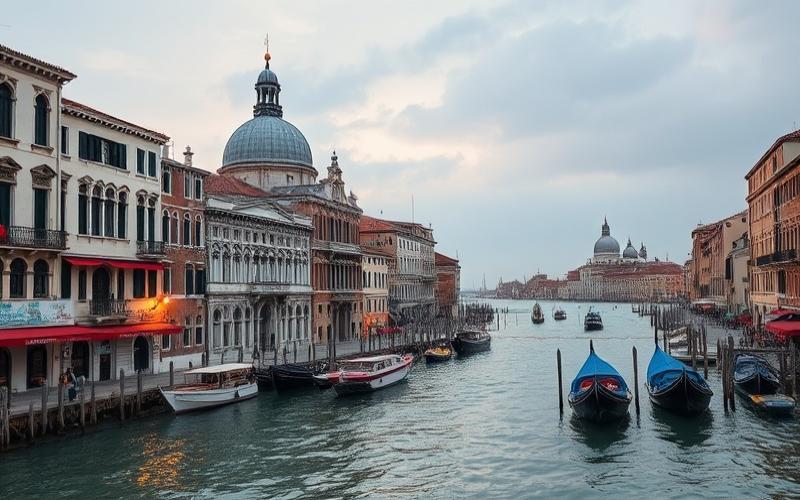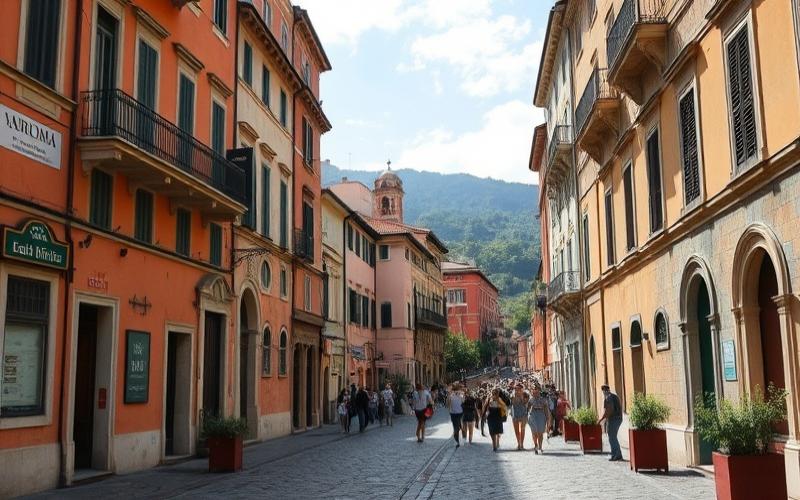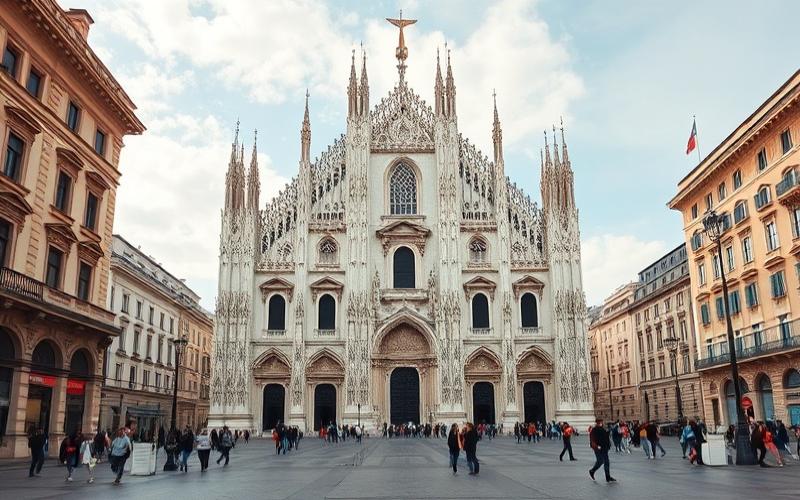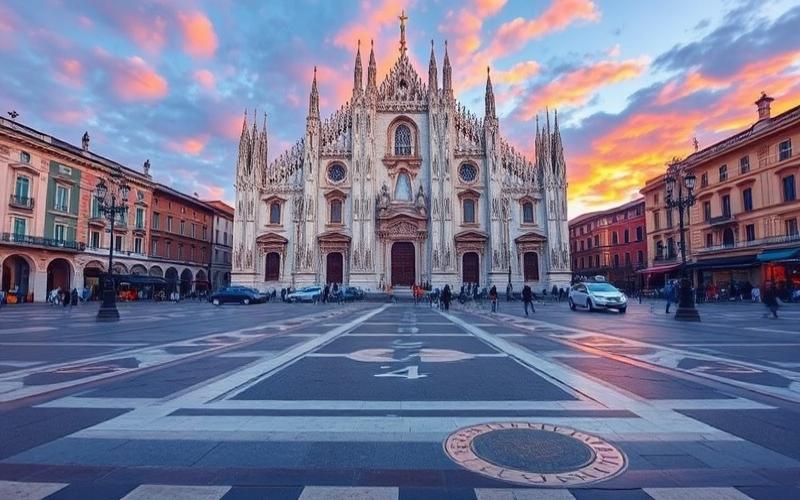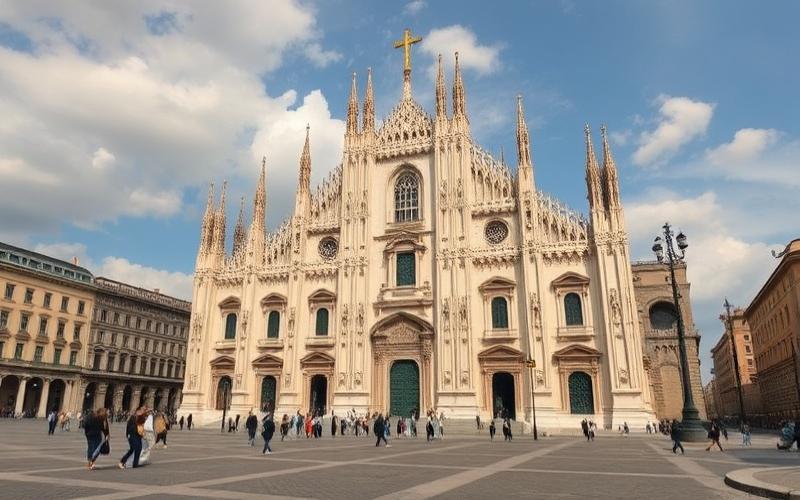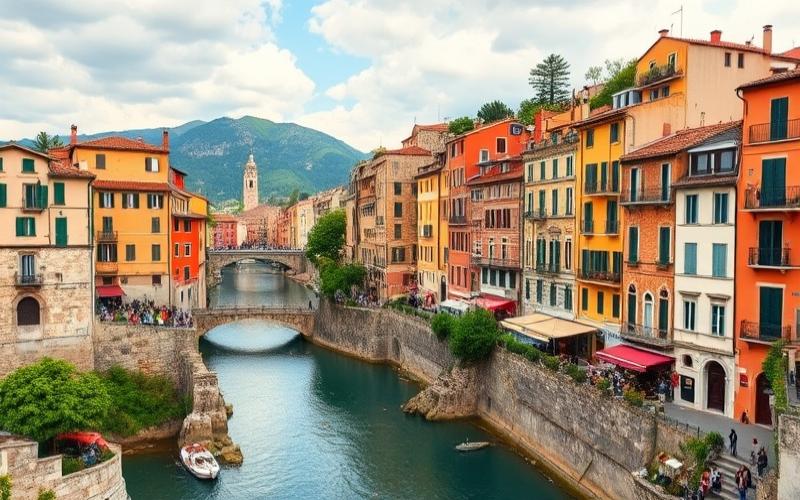
 Published on and written by Cyril Jarnias
Published on and written by Cyril Jarnias
Italy and the Emergence of “Dark Stores” in Real Estate
Italy, a land of contrasts and traditions, is now being transformed by an emerging phenomenon in the real estate sector: dark stores. These discreet storage spaces, born from the rise of online commerce, are profoundly altering the urban landscape of major Italian cities.
By reducing the boundary between physical and digital distribution, these urban warehouses open new perspectives for investors and consumers while raising questions about urban planning policies.
Good to Know:
Dark stores are urban warehouses optimized for rapid delivery, often invisible to end consumers.
In a context where the real estate market is constantly evolving, understanding the impact of these infrastructures becomes crucial for anticipating upcoming changes and seizing opportunities hidden behind the closed doors of these shadow logistics.
Rise of Dark Stores in Italy: A Shift in the Real Estate Landscape
Dark stores have recently spread across the Italian real estate market as local logistics spaces dedicated to preparing online orders, accelerated by the growth of quick commerce and ultra-fast deliveries, following a global trend of strong growth in the dark store segment. Although consolidated country-level data remains incomplete, Italy follows European trends where densification in well-connected urban areas precedes visible real estate and urban effects.
Urban Impact and Commercial Substitution
- Dark stores are established in ground-floor spaces or commercial premises repurposed as micro-warehouses, replacing traditional stores, particularly in central neighborhoods with high rents and purchasing power where demand for rapid delivery is strongest.
- This conversion alters the street-level commercial fabric: reduced diversity of active storefronts, decreased pedestrian destination traffic, and increased courier and light utility vehicle flows, with externalities (noise, short-term parking, usage conflicts).
- Targeted locations near mobility hubs (train stations, main arteries) and high-density residential areas, following models observed in Western Europe, lead to reconfiguring ground floors toward logistics uses invisible to the public.
Economic and Real Estate Effects
- Commercial: demand for flexible leases and spaces of 150–600 m² with ceiling height, logistics access, and extended hours supports prime location rents, although non-public access usage may be limited by local regulations. In central neighborhoods, competition with restaurants and premium services can drive up rents for small spaces, while secondary streets see increased vacancy absorption by dark stores.
- Residential: proximity to a dense dark store network may enhance perceived convenience (fast deliveries), but local nuisances and reduced street activity can neutralize the effect on values, producing highly localized and heterogeneous impacts depending on the street and municipal regulations.
- Urban Logistics: the rise of dark stores increases the usage value of ground floors for last-mile logistics, boosting investor interest in convertible retail/light logistics typologies in urban centers.
Consumer Trends
- Dark stores catalyze the shift from destination retail to on-demand commerce (groceries, fresh goods, health & beauty), with more frequent, lower-value baskets, aligned with global growth in quick commerce and e-grocery post-pandemic.
- Physical stores adapt through omnichannel strategies (click & collect, ship-from-store), hybridizing stores and micro-fulfillment to remain competitive against delivery times driven by dark stores.
Statistics and Geography (Reference Framework and Reading for Italy)
- Global Dark Store Market: estimated at approximately $22.8–23.3 billion in 2024, with a compound annual growth rate of about 38–41% through 2029–2035. Europe is among the high-adoption regions, driven by e-grocery and urban density.
- In the absence of recent official counts for Italy, expected hotspots concentrate in high-density, high-purchasing-power metropolitan areas (Milan, Rome, Turin, Bologna, Naples), following the documented European model, with priority penetration in well-connected central and peri-central neighborhoods.
- At the European scale, diffusion has been fastest in the UK, Germany, and France; Italy follows with more selective and regulated deployment, resulting in a more moderate but growing footprint in major cities.
Reactions from Authorities and Residents
- Local Authorities: increasing urban planning regulations aimed at controlling the conversion of stores into urban warehouses (usage definitions, access conditions, hours, nuisances, active storefronts), in line with European frameworks seeking to preserve street-level commercial activity.
- Residents and Merchants: concerns about quality of life (nuisances, courier traffic) and commercial de-specialization; demands for transparency on space usage and mitigation measures (delivery areas, soundproofing, active facade requirements).
Table — Key Observed Effects and Action Levers
| Domain | Key Effect of Dark Stores | Response/Recommended Lever |
|---|---|---|
| Ground-Floor Urban Planning | Substitution of stores with micro-warehouses | Precise zoning specifying uses, active storefront quotas |
| Local Mobility | Increase in delivery flows and short-term parking | Creation of dedicated areas, regulated time slots |
| Commercial Real Estate | Pressure on well-located small spaces, demand for flexible leases | Usage clauses, rules on logistics in city centers |
| Residential Real Estate | Heterogeneous impacts by street (convenience vs. nuisances) | Micro-local impact studies, neighborhood charters |
| Consumption | Acceleration of quick commerce and omnichannel | Incentives for sharing and sustainable delivery |
Points of Attention for Italy
- Map the most affected areas in metropolitan regions (historic centers and peri-central rings) and track commercial vacancy absorbed by fulfillment uses.
- Implement active facade indicators and delivery flow metrics to balance urban vibrancy and logistics efficiency.
- Regulate operating conditions (hours, noise, access) and promote soft logistics solutions (cargo bikes, shared hubs) to reduce negative externalities while maintaining service benefits.
Methodological Note
Sector sources provide robust measurements at the global and European levels, but recent public statistics on the exact number of dark stores in Italy and their distribution by city are not yet published in standardized form; estimates must be consolidated locally with municipal inventories and operator data.
Good to Know:
The rise of dark stores, these warehouses dedicated to preparing online orders, is significantly altering the Italian real estate market, with over 150 establishments already present in major cities like Milan and Rome. These spaces, often located in residential neighborhoods, sometimes replace traditional stores, thereby influencing urban planning and creating local economic tensions. The influx of dark stores can lead to increased commercial real estate prices, but paradoxically to stagnation or even decreased residential values in the most affected areas. This transformation also disrupts consumption habits, reinforcing the trend toward more frequent online purchases. Local authorities are beginning to respond to this shift, seeking a balance to maintain commercial diversity and city center appeal, while residents express concerns about the decline of their traditional living environment and the impact on urban friendliness.
Logistics Real Estate and the Last-Mile Delivery Challenge
Logistics real estate is the operational foundation of dark stores in Italy: it conditions preparation speed, unit costs, and last-mile service quality through dense urban locations, compact spaces, and optimized storage layouts. Dark stores derive their performance from proximity to demand pools (city centers, dense neighborhoods) and smaller spaces than traditional warehouses, often converted from former stores or ground-floor units, to reduce delivery time and distance.
Key Role and Location/Sizes
- Customer proximity: location in city hearts to accelerate picking and reduce last-kilometer delivery time.
- Compact surfaces: modules smaller than peripheral warehouses, capable of utilizing ground floors, former stores, or converted parking.
- Internal optimization: shelving dedicated to manual picking, short flows, high restocking frequency to maximize productivity per m².
- Cost/access trade-off: urban land costs increase initial investment; however, urban density justifies higher rents to maintain fast delivery times.
Specific Last-Mile Challenges in Italy
- Historic urban infrastructure: dense city centers and narrow streets complicate access, parking, and consolidation of rapid routes.
- Density and mixity: high-density neighborhoods favorable to demand, but subject to neighborhood and traffic constraints, similar to debates in other European capitals regarding the “warehouse” status of dark stores.
- Consumer behavior: expectation of fast and flexible deliveries (short time slots), requiring nearby micro-preparation nodes and high-turnover, lean inventories.
Innovative Solutions Deployed by Operators
Optimization Technologies
- Inventory management and picking systems designed to reduce preparation time via adapted shelving and picking routes.
- Last-mile routing algorithms and micro-zoning of service areas, made possible by the urban proximity of dark stores.
Sustainable Vehicles and Practices
Adoption of cargo bikes and light electric vehicles to navigate dense centers, limit noise and emissions, and improve access to narrow streets.
Local Cooperation
Location and usage adjustments in coordination with authorities (warehouse status, urban planning rules, delivery hours), similar to European legal frameworks classifying dark stores as warehouses subject to urban planning documents.
Data and Economic/Environmental Impacts on the Italian Real Estate Market
Dark stores favor urban locations where rents are higher, in exchange for reduced transport costs and delivery time, a logic observed in European markets where urban proximity is valued and conversion of vacant premises progresses.
Investments focus on reduced but picking-equipment-intensive surfaces, increasing usage value per m² and stimulating demand for micro-logistics assets in cities.
Environmentally, proximity to demand allows substituting short trips via soft modes for longer motorized routes, reducing kilometers traveled and local nuisances, provided upstream restocking is well scheduled.
Brief European Comparison
Switzerland: targeted rent increases near centers, conversion of former commercial/industrial spaces into logistics areas, and public debate on urban and environmental impact, illustrating tensions similar to Italy between logistics performance and regulatory framework.
Croatia: preference for central locations, compact and adaptable surfaces (former stores, parking), with strong focus on courier accessibility—a trajectory comparable to major Italian cities.
Urban Europe in general: classification of dark stores as “warehouses” influences ground-floor location possibilities and operating conditions, a point of vigilance also relevant for Italian cities.
| Dimension | Italy (Dark Stores) | Switzerland | Croatia |
| Location | Dense neighborhoods, customer proximity, compact surfaces | City centers, conversions, targeted rising rents | Central neighborhoods, ground floors, converted parking |
| Size / Layout | Micro-warehouses optimized for manual picking | Reconfigured urban spaces, high land costs | Surfaces smaller than traditional warehouses |
| Last Mile | Narrow streets, density, high speed expectations | Debates on nuisances and regulation | Priority on courier accessibility |
| Framework / Regulation | Necessary local coordination on “warehouse” usage | Increased regulatory and social pressure | Adaptability and conversion of urban spaces |
| Environment | Gains via soft modes and short trips | Discussions on footprint and urban coexistence | Route optimization and proximity |
Good to Know:
Logistics real estate plays a crucial role in Italy to optimize dark store efficiency, requiring strategic locations near urban centers and sufficiently large spaces to store and distribute products effectively. The last-mile delivery challenge is accentuated by complex road infrastructure and high urban density, making fast and flexible deliveries essential to meet Italian consumer behaviors. Operators innovate with advanced technology integration, use of electric vehicles, and collaborate with municipalities to improve delivery routes. According to recent data, these practices enhance sustainability and reduce carbon impact, while economically contributing to the real estate market, similar to Germany where comparable practices also boost this sector in the context of dark stores.
Opportunities and Risks of Investments in Italian E-commerce
Demand for e-commerce in Italy is growing strongly, driven by digital adoption, mobile-first approaches, and category expansion (Food & Grocery, Beauty & Pharma), with a market expected around €62 to 73 billion in 2025 according to sources, and continuous progression through 2028-2029. This dynamic intensifies needs for urban logistics and dark stores, directly influencing the scarcity and valuation of real estate in urban and suburban areas.
Structural E-commerce Trends
- Sustained revenue growth, between approximately +6% in 2025 and an estimated CAGR of 6.7–8.5% through 2028-2029.
- Acceleration in Food & Grocery and Beauty & Pharma segments, essential for rapid delivery and urban proximity.
- Market consolidation (M&A) and internationalization, reinforcing requirements for high-performance logistics infrastructure.
- Increase in online buyer penetration and average revenue per user, supporting a more predictable demand base for distribution networks.
Influence on Urban and Suburban Real Estate
- Dark stores and local micro-hubs gain ground to reduce last-mile and accelerate delivery times, increasing pressure on well-located surfaces in city centers and first-ring suburbs.
- In peripheral areas, demand turns toward cross-docking warehouses and so-called “last-touch” platforms, favoring the redevelopment of industrial zones and rising prime logistics rents.
- Competition between uses (commercial, residential, urban logistics) results in increased scarcity, stronger tenant selectivity, and more specialized leases for operations (hours, flows, noise).
Major E-commerce Companies Operating in Italy and Urban Effects
- Global players and multi-brand platforms (marketplaces, retail media) stimulate logistics sophistication and densification of urban execution points.
- Strategies focused on ultra-speed in food and beauty reinforce the micro-warehouse network and route optimization, redesigning certain traffic arteries and loading/unloading zones.
- Consolidation and omnichannel expansion drive the conversion of underperforming commercial premises into preparation and pickup units, especially in neighborhoods with high demand density.
Table — Key Real Estate Effects of Dark Stores
| Dimension | Urban (Center/First Ring) | Suburban/Peri-urban |
|---|---|---|
| Asset Type | Converted commercial premises, ground-floor logistics, micro-hubs | Cross-docking warehouses, last-touch, regional platforms |
| Value Impact | Upward pressure on rents for suitable surfaces, premium for locations with delivery access | Revaluation of well-connected assets, yield compression on prime |
| Availability | Decreased vacancy for technical surfaces (docks, ventilation, noise) | Increased demand for clear heights, heavy vehicle parking |
| Urban Planning | Negotiation on hours/flows, urban integration | Redevelopment of brownfields, road infrastructure needs |
Potential Benefits for Real Estate Investors
- Access to creditworthy large tenants and specialized leases offering better revenue visibility.
- Opportunities for value creation through conversion of obsolete assets into urban logistics and densification of mixed uses.
- Portfolio diversification by capturing structural growth driven by consumption digitalization.
Main Risks
- Demand volatility and normalization post-growth peaks, with variations by category and economic cycles.
- Municipal regulatory changes (nuisances, hours, traffic, signage) potentially restricting dark store locations in city centers.
- Logistics challenges: last-mile costs, congestion, availability of qualified labor, and access constraints.
- Specific vacancy risk if formats evolve (shift from quick commerce to more rationalized models) and if technical standards become more demanding.
Impacts on Traditional Stores and Residential Areas
- Increased competition in certain categories, accelerating the transformation of shopping streets and conversion of boutiques into execution or pickup spaces.
- Neighborhood tensions: delivery flows, noise, and public space occupation, requiring operating charters and adapted urban planning.
- Potential proximity effects for residents: improved service offerings and delivery times, but nuisance risks and increased commercial rents.
Points of Attention for Investment Strategy
- Prioritize assets with strong accessibility (delivery radii—contact me to discuss your project and obtain personalized advice enabling informed and profitable choices.
Disclaimer: The information provided on this website is for informational purposes only and does not constitute financial, legal, or professional advice. We encourage you to consult qualified experts before making any investment, real estate, or expatriation decisions. Although we strive to maintain up-to-date and accurate information, we do not guarantee the completeness, accuracy, or timeliness of the proposed content. As investment and expatriation involve risks, we disclaim any liability for potential losses or damages arising from the use of this site. Your use of this site confirms your acceptance of these terms and your understanding of the associated risks.













